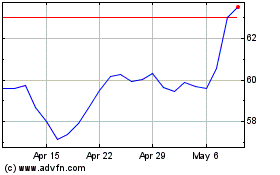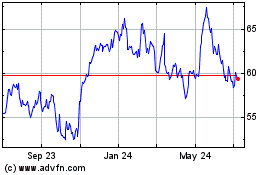AB InBev Details Merger Job Cuts -- WSJ
August 27 2016 - 3:03AM
Dow Jones News
By Tripp Mickle and Laurence Norman
Anheuser-Busch InBev NV on Friday said its beer megamerger with
SABMiller PLC could lead to thousands of job losses in coming
years, according to disclosures related to the transaction.
Based on integration planning, the Belgian-based brewer expects
to cut at least 5,500 jobs after the merger. An AB InBev
spokeswoman said that number could change as the integration of the
two businesses proceeds.
AB InBev said the "job reductions will be implemented gradually,
in phases, over a three-year period" and would equate to about 3%
of the workforce of the combined companies. The estimate at this
point doesn't include possible reductions in sales and front-office
supply staff; the company said "regulatory restrictions" prevent it
from evaluating those functions during integration planning.
AB InBev currently employs about 150,000 people, while SABMiller
puts its workforce at roughly 70,000. However, SABMiller is due to
shed most of its European assets under the deal.
The cuts will contribute to AB InBev's expected $1.4 billion in
annual cost savings by the end of the fourth year after the
transaction. Additional savings will come from raw-material
procurement and other improvements.
The documents disclosed to shareholders show AB InBev and
SABMiller combined will spend nearly $2 billion on closing costs
and fees related to the transaction, amounting to a big payday for
bankers, lawyers and consultants.
AB InBev will spend almost $1.74 billion, including $725 million
in financing arrangements; $475 million in transaction taxes and
other costs; $135 million for financial advice to Lazard Ltd. and
others; $185 million on legal advice; $180 million on management
consultants and other services; $20 million on public-relations
advice; and $15 million on accounting advice.
SABMiller will spend $202 million in closing fees, including
$113 million on financial advice to Robey Warshaw LLP and others;
$76 million on legal advice; $9 million on public-relations advice;
and $4 million on accounting advice and other costs.
AB InBev and SABMiller expect to close the $100 billion-plus
merger on Oct. 10. The transaction would create a global beer giant
with more than 400 brands and a roughly 26.8% share of the world's
beer market, according to industry tracker Plato Logic.
Friday's filings also disclose for the first time that AB InBev
approached some SAB Miller board members about a combination much
earlier than previously thought -- about 10 months before news of
it broke. In December 2014, one of the Belgian brewer's major
shareholders -- who wasn't identified -- approached representatives
of the Santo Domingo family, which owns roughly 14% of SABMiller,
about a merger. An AB InBev representative later broached the
possibility with Altria Group Inc., the tobacco company that has an
approximately 27% stake in SABMiller.
After months of talks, AB InBev shared a nonbinding term sheet
with Altria and the Santo Domingos in August 2015, setting in
motion a deal that would combine the world's two largest brewers.
They announced their agreement on Nov. 11, 2015.
Acquiring SABMiller would give AB InBev access to the
fast-growing African beer market and reduce its reliance on the
U.S. AB InBev said Africa is expected to represent 8.1% of global
beer volumes by 2025, up from 6.5% in 2014. Beer volumes on the
continent are expected to grow three times faster than global
industry volumes, according to the documents. The deal also gives
AB InBev new territory to expand sales of its global beer brands
Budweiser, Corona and Stella Artois.
AB InBev has set a target of raising revenue to $100 billion by
as early as 2020. The brewers stated combined annual revenue of
$55.46 billion in the documents released Friday.
The documents said the combined company's business model will
focus on "organic revenue growth ahead of the industry, coupled
with tight management costs." Key to that will be AB InBev
strategies such as "zero-based budgeting," a system that requires
managers to plan each year's budget as if no money existed the
previous year. It forces them to justify costs and has helped
foster AB InBev's reputation as a cost-cutter.
Write to Tripp Mickle at Tripp.Mickle@wsj.com and Laurence
Norman at laurence.norman@wsj.com
(END) Dow Jones Newswires
August 27, 2016 02:48 ET (06:48 GMT)
Copyright (c) 2016 Dow Jones & Company, Inc.
Anheuser Busch Inbev SA NV (NYSE:BUD)
Historical Stock Chart
From Mar 2024 to Apr 2024

Anheuser Busch Inbev SA NV (NYSE:BUD)
Historical Stock Chart
From Apr 2023 to Apr 2024
